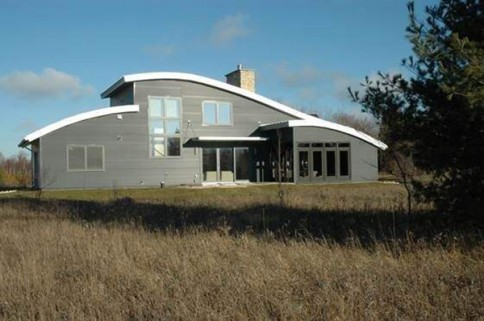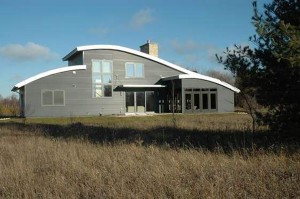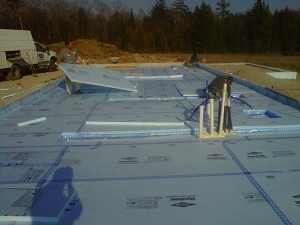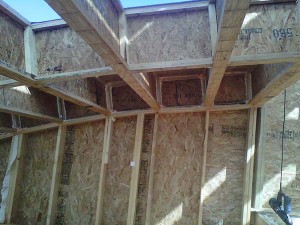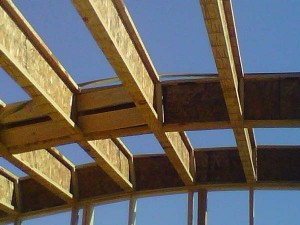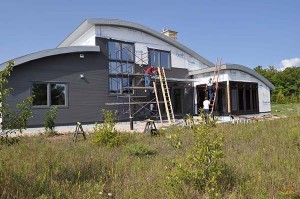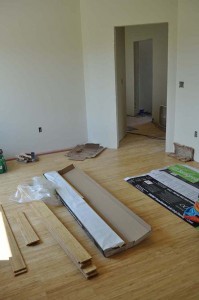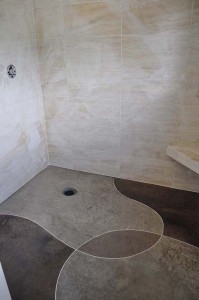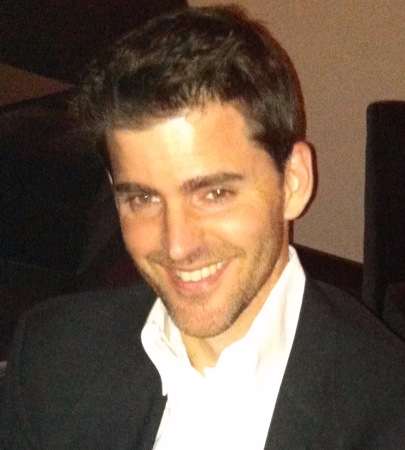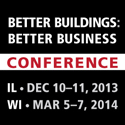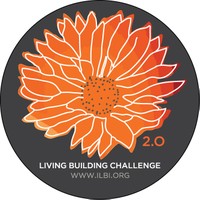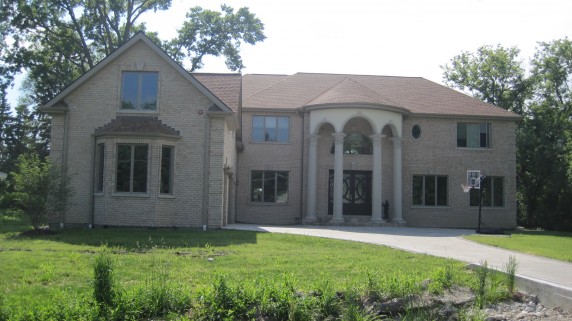WI Platinum 2.5k Square foot Home averages $30 energy bills
/0 Comments/in Local, Certified Homes, Illinois, Indiana, LEED Platinum, Michigan, Minnesota, Ohio, Single-Family Projects, Wisconsin/by Brett LittleThanks to Jetson Green for sharing this awesome post! (Article written by Christine Walsh on Nov. 28, 2013)
Architect Virge Temme of Sturgeon Bay, Wisconsin recently received the LEED Platinum for Homes certification for a private residence she designed near Gills Rock. The home was built by Bay Lakes Builders, and the plans were based on the collaboration of all members of the construction and design team so as to ensure proper integration of all systems. The electric and fuel bills for this 2,600-square-foot house were less than $30 per month on average during its first year. This is only the seventh home in Wisconsin to receive the LEED Platinum certification.
The building process started with the excavation of the meadow where the house stands, while the top soil was stockpiled and used for final grading later. Once the foundation was complete, the foundation forms were stripped and the below-slab plumbing and electrical runs installed. The builders continued with laying thermal tarp to protect the home from freezing rains. This was followed by the installing of under-slab insulation. All the joints were staggered and sealed in this process to prevent air movement between layers. Furthermore, all the penetrations through insulation were foam sealed, which protects against cold seepage and potential Radon gasses.
The roof was then installed, using 16″ I-joists to reduce thermal transmission and to provide additional insulation depth. The I-joists were placed directly over the studs below and the framed walls with studs at 24″ on center to reduce redundant top plate, which also reduced the overall framing materials need. The rafters were then screwed and strapped to studs to provide additional protection from wind. All the intersections were then foam-sealed.
To provide a continuous envelope 3/8″ OSB was added to the under side of rafters. Double 2-4 plates were screwed below the rafters to provide an electrical chase, eliminating the need for roof penetrations. The builders also used ladder framing, which greatly reduced the amount of redundant materials at wall-to-wall connections. Double-wall construction also eliminated thermal bridging and provided space for additional insulation.
The house has insulation values of R-45 for walls, R-60 for the roof, and R-30 for ground insulation. Together with passive solar orientation and specially-coated windows to introduce solar warming, and which also feature overhangs to protect from summer over-heating, there is no need for a furnace or a boiler for space heating.
Other sustainable features of the home include:
– Sustainably-harvested framing materials
– Recycled/recyclable metal siding, roofing and insulation
– Drought-tolerant plants replanted around the home
– Rain gardens for roof runoff
– Only low- or no-VOC paints, adhesives and insulation were used to ensure better air quality
– Floors are made of concrete and sustainably harvested bamboo
– Only highly efficient appliances, lighting fixtures, and plumbing were installed
– The building process resulted in almost no construction waste
View LEED project Profile Here
Article tags: alternative energy, Development, energy efficiency, green building, LEED,leed certification, LEED Platinum, modern architecture, modern design, passive house, residential, water efficiency
Vote for Michael Hobbs to be on the USGBC-Illinois Board of Directors!
/0 Comments/in Local, Illinois, Miscellaneous/by Brett LittleI’ve been selected as a candidate for an at-large director position on the USGBC-Illinois Chapter 2014 board and I’m asking for your vote. If you are a member of USGBC-Illinois, please take the time to cast your vote before December 1 at 6pm!
Michael Hobbs, SRA, LEED GA
President
PahRoo Appraisal & Consultancy
P: 773.388.0003
www.pahroo.com
Candidate Particulars
|
| Why do I wish to be a member of the USGBC-Illinois Board? |
|
| Please provide a summary of your professional qualifications, knowledge and experience of most relevance to the Chapter. Also indicate the degree to which you have senior management and executive level experience. Please include any current work you may be doing for the chapter. |
|
| The Chapter is committed to strengthening its membership diversity. What resources could you bring to bear (e.g., demonstrated expertise, leadership positions, and willingness) to help further Chapter participation from high priority sectors including: real estate, energy/utility, finance/insurance, residential, corporate, product manufacturing and developers? You can also address other sectors you think require greater involvement in the Chapter. |
|
| Describe what expertise, experience and resources from other organizations with successful chapter programs. |
|
| Describe what expertise, experience and resources you’ve experiences in leadership positions (volunteer or professional staff) with nonprofit governance. |
|
| Candidate Information |
| Reference Letters |
| LinkedIn Profile |
Banked & Recorded Green Home Webinars – Free! CEUs
/0 Comments/in Local, Education and Events, Illinois, Indiana, Michigan, Minnesota, Ohio, Tools and Resources, Wisconsin/by Brett LittleThe webinars below are a summary of educational offerings that is prepared to deliver upon request or are recorded and accessible for free. Many are approved for AIA and GBCI continuing education credit. Contact us to schedule a presentation or if you would like to present through our network.
- Demystifying LEED for Homes Version 4 webinar featuring lead LEED home reviewer Jay Hall – 1 hour – CEUS
- Rosemarie Rossetti from the Universal Design Living Laboratory has 1 hour recorded webinar that takes you through her ZeroStep Certified Gold Home in Columbus Ohio and explains the thought behind the design and construction. This is a free webinar worth 1 AIA/GBCI/Nari Green & Potential State Contractor CEU.
- Introduction to the GreenStar Remodeling Certification Program – 1 Hour Webinar (AIA/GBCI/NARI Green)
- Materials Matter- Design Trends for a Sustainable Future – WoodWors.org (AIA/GBCI)
- How I made Million Dollars as a Green Remodeler – GreenStar Remodeling Certification Kick Off
- Energy Star Version 3 for HOMES – Lessons Learned for HVAC Contractor Design/Install AIA/GBCI CEs
- Selecting Appropriate Natural Building Materials in Cold & Wet Climates 5/7/13 on Demand AIA/GBCI CEs
- PHIUS + Passive Building Certification – Webinar Recorded 3/18/13 – 1 AIA/GBCI on demand
- Journey to Passive House & LEED – A Homeowner’s Tale – Record Feb 2013 (1 hour)
- Making Green with Green – Introduction to Green Remodeling for Homes – 1 AIA/GBCI
- LEED for Homes Post Occupancy Report – Recorded Jan 2013. GBCI Only
- Achieving Success in Education & Awareness – LEED for Homes – 2012 Recording 1 AIA/GBCI (LEED Specific)
- LEED Multifamily Certification Options (1 AIA/GBCI)
- Overview of LEED for Homes (1 AIA/GBCI)
- 10 tested tips for LEED for Homes Gut Rehabs – (1 AIA/GBCI)
As a 501(c)3 charitable organization (view our details), we deliver green building education courses throughout the Midwest at minimal cost and at no profit. Please support us to help keep these going. Your donation to the Green Home Institute may be tax-deductible. Please check with your accountant or tax attorney for details.
Thank you for your support!
By USGBC – FREE webinars on Affordable Housing:
- Affordable Green Multifamily Retrofits
- Operations & Maintenance of Green Affordable Housing
- Data Collection and Analysis of Green Affordable Housing
Green Building & Remodeling Tax Credits
/0 Comments/in Local, Economics, Illinois, Indiana, Michigan, Minnesota, Ohio, Tools and Resources, Wisconsin/by Brett LittleThere are currently 2 Federal tax credits for energy efficiency and 1 commercial tax deduction. Information on the forms needed to claim these are in bold below. Most LEED for Homes or GreenStar projects will also meet the eligible requirements of the tax credits
Tax Credits for Energy-Efficient Home Improvements
What: Tax credits equal to 10% of the material costs paid by the taxpayer for qualified energy-efficient improvements installed from January 2012 through December 2013.
Who: Homeowners
Limits: Improvements installed in 2012 and 2013, can get a maximum credit of $500. If you have claimed more than $500 in energy-efficient tax credits since January 1, 2005—you are not eligible to make a tax credit claim in 2012 or 2013.
Claim: Use IRS Tax Form 5695 (version 2009).
NOTE: For insulation to qualify, its primary purpose must be to insulate. It must be expected to last five years OR have a two-year warranty. Installation costs are not included. GreenStar Remodeling Certification Can help!
Builder Tax Credit for Energy-Efficient Homes:
What: $2,000 tax credit for new, energy-efficient homes that achieve 50% heating and cooling savings over a comparable dwelling unit constructed in accordance with the 2006 International Energy Conservation Code (IECC) and supplements. LEED for Homes certified projects with applicable HERS scores will qualify.
Who: Home builders
Limits: The credit is retroactive to January 1, 2012 and covers homes built through December 31, 2013 for homes sold or leased in 2012 and 2013.
Claim: Eligible contractors should fill out IRS Form 8908.
Commercial Tax Deduction:
What: Tax deduction of up to $1.80 per square foot for new or existing commercial buildings that save at least 50% of the heating and cooling energy of a building that meets ASHRAE Standard 90.1-2001.
Who: Owners or designers of new or existing commercial buildings.
Limits: Available for systems “placed in service” from January 1, 2006 through December 31, 2013.
NOTE: Partial deductions of up to $.60 per square foot can be taken for measures affecting any one of three building systems: the building envelope, lighting, or heating and cooling systems. LEED for Homes Midrise Certified Buildings will help to achieve requirements
Claim: Check with your accountant to claim this deduction.
Will this be renewed in 2014?
No word yet. Most of them have been renewed for several years. But with all that’s going on, I don’t think it’s at the top of the agenda. Usually if it’s renewed it happens at the very end of the calendar year or the first couple of months of the next.
You also can find a list of local tax incentives at www.dsireusa.org.
If you only attend one conference this year
/0 Comments/in Education and Events, Illinois, Indiana, Tools and Resources, Wisconsin/by Brett LittleIf you can only attend one conference this year—the Better Buildings: Better Business Conference is the one
The residential, multifamily and small commercial building and remodeling community will come together December 10-11, 2013 at the second annual Illinois Better Buildings: Better Business Conference®. The conference has a new convenient location at the Crowne Plaza near Chicago O’Hare and attendees can expect to get the latest information on building technologies, strategies, techniques, financial incentives, code requirements and more.
Whether you’re looking to obtain continuing education credits (more than seven hours of continuing education for builders, remodelers, contractors, architects, building performance consultants, home inspectors, raters, LEED APs, LEED Green Associates and more are available), stay ahead of the latest trends, increase your technical skills and code knowledge, find new business opportunities or learn new ideas—the Illinois Better Buildings: Better Business Conference is a not-to-be-missed event. The conference will feature 42 sessions and 44 topnotch local and national experts who will share their knowledge in various platforms to fit different learning styles.
You’ll start off the conference in the newly designed expo to experience the general session. This action-packed session will host industry leaders who will make their best predictions about what the future may hold and help to prepare you for what’s to come. Sessions and live, for-credit demonstrations will be in full swing following the general session. You can choose from 12 different tracks and attend an entire track or mix and match the sessions that interest you most. You’ll definitely want to check out the demos at some point. These reality-based learning experience will give you the chance to challenge the technology and talk with those who know their products best. Finally, after taking in all that learning you’ll need some time to unwind. The social highlight of the conference—the reception on Tuesday night—will give you a chance to mingle with exhibitors and catchup with like-minded colleagues. There will even be a chance to participate in a friendly competition. Then, you’ll start it all over on Wednesday morning.
Hope to see you there. Visit betterbuildingsil.org, take a look at the complete session program and register today.
ZeroStep Certification
/0 Comments/in Local, Illinois, Indiana, Michigan, Minnesota, Miscellaneous, Ohio, Wisconsin/by Brett LittleEnvironmental Sustainability () are joining forces to take, ZeroStep™, a certification for home and building accessibility, beyond its current multi-state capacity to influence home construction over the rest of the country. The ZeroStep™ standard is based in universal design which, according to DAKC Executive Director, David Bulkowski, J.D., is “an approach to creating environments and products that are usable by all people to the greatest extent possible.”
Why?
Twenty percent of Americans have accessibility needs and that number is growing. ZeroStep ™ helps to influence the design, development, construction, and use of new and existing homes through training, education, design review and third party verification/certification of proper construction.
Sign up
Zerostep 1.0 is now available for plan review and plan certification. Please review the program Guidelines & Checklist and then Register your project here by answering a few quick questions. From there we will follow up with you and give you online access to submit your plans.
Progress
ZeroStep 2.0 Development is underway and will include not only Universal Design but opportunities and guidance on Aging In Place, ADA, Assistive Technology, Visibility and other necessary accessibility issues. Be on the look out for program upgrade by Spring 2014.
Questions? Brett.Little@allianceES.org or 616 458 6733 ext 1
See ZeroStep in Action – Rosemarie Rossetti from the Universal Design Living Laboratory has 1 hour recorded webinar that takes you through her ZeroStep Certified Gold Home in Columbus Ohio and explains the thought behind the design and construction. This is a free webinar worth 1 AIA/GBCI/Nari Green & Potential State Contractor CEU.
In the News.
featured in Chicago 7 News helping make a home more accessible and therefore sustainable:
ABOUT ZeroStep ™
ZeroStep™ takes universal design for homes, which is the art and science of creating environments that are attractive, marketable, and user friendly for people of all ages, desires, and abilities, to the next level with the intentional accommodation of people’s needs for their total life span. As people’s needs change, their home remains accessible and family friendly.
The value of ZeroStep™ is its applicability to commercial buildings, retail spaces and even neighborhood design because it just makes good sense. Joanne Feutz, a co-author of the ZeroStep™ Guidelines, describes the value as:
“For an architect, builder, and developer, the ability to advertise a home as “ZeroStep™ Certified” and use the ZeroStep™ logo says that you are not only about quality homes, but also about responsible and sustainable building. ZeroStep™ universally designed homes are a personal or company mindset, philosophy, and choice exceeding the standard perceptions of quality to include comprehensive home designs that enhance all stages of life for everyone.
For the home owner or home buyer, ZeroStep™ Certification means the home not only meets, but exceeds current standards for residential construction. It also means they can expect a return on their investment because the home addresses not only today’s needs but tomorrow’s needs, as well as saving costs in remodeling or possibly relocating.
“A ZeroStep™ Certified Home is truly a home for a lifetime,” says Renee Thompson, a co-author of the ZeroStep Guidelines. She built a ZeroStep home in 2006 for her young growing family. “I love our ZeroStep home because it is first and foremost family friendly. It accommodates our ever changing stages of life very cost effectively from babies in strollers, teens on crutches, mom recovering from surgery to grandpa in his wheelchair. I’ve come to realize that people do not notice our home has ZeroStep entries until they need it. That’s when they realize the true value of ZeroStep. We chose ZeroStep because we believe it is the smart way to build. Why wouldn’t you build a home that works for you and your family both today and in the future?”
LEED Homes: New Energy Pathway & Program Market Share
/0 Comments/in Economics, Green Home Institute, Illinois, Indiana, Michigan, Minnesota, Ohio, Wisconsin/by Brett Little“Starting with the LEED NC program, multifamily adoption of LEED really took off when the LEED for Homes and LEED Midrise programs were
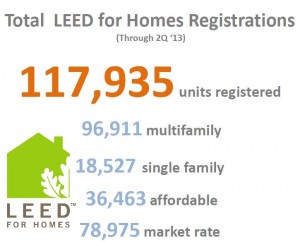
launched in 2008. With only 4,000 units participating as of 2009, the LEED for Homes (and LEED Midrise) programs have grown to include over 117,000 units pursuing certification today. Much of this adoption has been in the multifamily market. Nearly 90% of the units in the residential LEED programs are from multifamily buildings and as far as market share goes, during 2012 over 10% of all new US multifamily units chose LEED certification. “ Read More – Taken from USGBC.org
Based on the National Association of Home Builders Housing Start Data in the Midwest – LEED for Homes program market share has 2.1% of all new housing starts in 2012 including Multi Family and Single Family and was 1.3% of from Jan – May in 2013 (Included a 10K + Housing start increase). This really shows that those who choose LEED for Homes as their path are the top leaders in their field.
Out of the 40 Providers in the country has remained around the 10th for LEED for Homes Project Registrations & Certifications, with over 2,600 units certified and 6,000 + registered. You might be saying so what? What is the points of registration? Registration under LEED expresses intent. First off, it is not free and likely someone will not be paying to register until they have thought about the basic principals of LEED; Energy / Water / Location Efficiency, Improved Indoor Air Quality, Durability, Waste Reduction, Materials Choice and Education/Awareness. Most projects that have registered have engaged design, construction and energy/green rater professionals in order to think differently about their project and design for above code success. Whether they certify or not, we are excited about the upfront work and thought that leads to registration, finding the first step to be noteworthy.
 USGBC nationally has now certified just over 40,000 units or a 3rd of all registered projects. Certification means the project team has subjected it self to 3rd party onsite visual verification and performance energy testing with Energy Star for Homes and the Home Energy Rating Score. Certification is not easy and shows the team has taken the steps to ensure their project is more sustainable and the house will be Energy Efficient, Healthy for Occupants, Built to Last and Attainable by Anyone.
USGBC nationally has now certified just over 40,000 units or a 3rd of all registered projects. Certification means the project team has subjected it self to 3rd party onsite visual verification and performance energy testing with Energy Star for Homes and the Home Energy Rating Score. Certification is not easy and shows the team has taken the steps to ensure their project is more sustainable and the house will be Energy Efficient, Healthy for Occupants, Built to Last and Attainable by Anyone.
Why are we so excited?
At we celebrate all certified projects by show casing their accomplishments. This happens through helping set up tours to educate the public, documenting post occupancy success based on utility data / indoor air quality studies and overall comfort and homeowner satisfaction. After following up with homeowners and contractors we are showing others how they could accomplish LEED best practices and ideal certification at an affordable manner.
Anything less would be a failure to support our mission, we are not in the business to just certify homes but to use that certification as a success story.
As continues to pursue and celebrate LEED certification success with our community we are excited to see the USGBC continue to push the envelope.
“Continuous improvement ensures that the LEED rating systems stay relevant in a time when policies, technologies and the needs of the industry are constantly changing. In the last three years, residential construction energy codes rapidly have become more stringent, a trend we anticipate will continue. The updates in LEED v4 (the newest version of LEED for Homes) respond to these changes, and now USGBC aims to update the 2008 version of LEED for Homes by beginning an official update process. “
A ballot proposal is out to for “v2008 that will increase the stringency of the energy prerequisite by roughly 15%, approximately equivalent to the energy performance of ENERGY STAR v3, 15% above International Energy Conservation Code (IECC) 2009 and equivalent to IECC 2012. ” Before a HERS Score of 85 was acceptable on a LEED certified home but this would push it to require a HERS of 70 now starting on April 1st 2014
” Currently, over 90% of all certified projects are scoring lower than a HERS 70.” Learn more here
In order to keep the relevancy of the LEED for Homes program which has given a language to LEED. We celebrate registrations and certification, education and constant improvement is the direction to go.
Also see this report on Michigan
Click to access Green%20Building%20Market%20Brief%20and%20Snapshot_Michigan_0.pdf
Understanding the Living Building Challenge Midwest Fall Courses
/0 Comments/in Local, Illinois, Indiana, Michigan, Minnesota, Ohio, Wisconsin/by Brett LittleUnderstanding the Living Building Challenge provides a 6-hour in-depth introduction to the Living Building Challenge. Attendees are the green building leaders in their community: design professionals, contractors, developers, owners, government officials and employees of public agencies. In short, anyone and everyone who can impact the development of the built environment.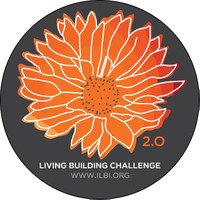
Workshop Overview:
9:00-10:00 The Philosophy of the Living Building Challenge / Petal rationale + strategies: Site
10:00-10:15 Break
10:15-11:45 Petal rationale + strategies: Water, Energy, Health / Small Group Discussion
11:45-12:30 Lunch + Case Studies
12:30-2:00 Petal rationale + strategies: Materials, Equity, Beauty / Small Group Discussion
2:00-3:30 Breaking down Barriers / Community + Tools / Full Group Discussion /
Learning Objectives:
– Identify the key components of the Living Building Challenge
– Discuss the rationale for restorative design principles
– Understand successful strategies for compliance with each performance area
– Recognize financial, regulatory and behavioral barriers and incentives related to high performance design
– Describe the Living Building Challenge Community resources and certification process
Added Benefits:
– Applicable toward Living Future Accreditation
– Approved for 6 GBCI Continuing Education hours
– Approved for 6 AIA Learning Units
– Morning coffee and lunch included
Price*:
Ticket Type Registration
ILFI/Cascadia Members, Community subscribers, Ambassadors, Partners, Partner Org. Early Reg. $195
General Registration Early Registration $295
Non Early Bird
ILFI/Cascadia Members, Community subscribers, Ambassadors, Partners, Partner Org. Late $215
General Registration Late $345
*Registration Fee includes workshop materials, morning coffee and lunch.
Sponsorship Opportunities are available. Please contact development [at] living-future [dot] org for details.
| Wed, Sep 25, 2013 9:00 AM – 3:30 PM |
Understanding the Living Building Challenge 6 Hour Seminar Emanuel Community Center Cincinnati Ohio |
6 AIA/GBCI
|
| Mon, Oct 14, 2013 9:00 AM – 4:30 PM |
Understanding the Living Building Challenge 6 Hour Seminar – Grand Rapids Herman Miller GreenHouse Holland Michigan |
6 AIA/GBCI
|
| Thu, Nov 7, 2013 10:00 AM – 4:30 PM |
Understanding the Living Building Challenge 6 Hour Seminar Energy Center of Wisconsin Madison WI |
6 AIA/GBCI
|
Our Expert Faculty: Richard Graves
Richard has extensive experience establishing and supporting green building programs in national and international settings. A registered architect with degrees from Rice University and Virginia Tech, Graves was the U.S. Green Building Council’s Senior Vice President of Community. He has over a decade of field experience working on leading-edge green building projects and is a staunch advocate for transparency and responsibility in the building industry.
It may be big but did you see the energy bills?
/0 Comments/in Local, Certified Homes, Green Home Institute, Illinois, LEED Certified, Project Type, Single-Family Projects/by Brett LittleThis home was cons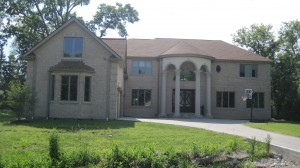 tructed with environmentally friendly materials and products. The goal was to build a home that didn’t have a negative impact on the environment and would contribute to the home’s overall efficiency.
tructed with environmentally friendly materials and products. The goal was to build a home that didn’t have a negative impact on the environment and would contribute to the home’s overall efficiency.
The result is beautiful home outfitted with natural bamboo hardwood floors, geothermal heating and cooling, superior insulation and Anderson Triple Pane Windows. The house’s construction, due to its part being pre-fabricated offsite, diverted almost all waste from landfills.
The home has greatly reduced utilities due to its design, costing $150 a month or $1,700 a year due to temperature moderation, Energy Star certified ceiling fans in all rooms, water conserving (Water Sense) faucets, and low flow 1.28GP toilets.
This home utilizes geothermal heating and cooling, which brings up 55 degree air from the earth’s crust, to effectively moderate the home’s temperature. The house also has Structure insulated panels (SIP) installed for throughout the entire house, reducing the amount of onsite wastes and greatly increasing insulation. The Kitchen, Foyer, and Great Room, all have insulation with an R-value of 40, while all other rooms are at R24. The attic, garage, and roof have an insulation of R40, but utilize spray foam insulation.
The Superior Wall Foundation was precast in Michigan with moisture resistant 5,000 psi concrete and placed on crushed stone footing to redirect water away from the foundation. The foundation itself also includes R17 insulation to further reduce air leakage in the home.
Due the concrete foundation and sealing of cracks and joints in the foundation, the house has good protection against pests like termites. The house also has a significantly reduced air leakage envelope, which is rated at 5.0 air changes per hour at 50 pascals (5.0 ACH50) All ducts were installed in conditioned space, so there is no leakages withing duct work. The lawn consists of “No Mow Grass” which does not require fertilizer, mowing, or watering in its maintenance.
Projec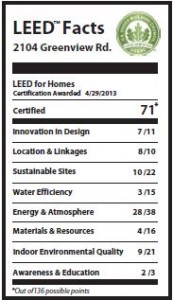 t Details
t Details
Type Single Family
Conditioned Space 7,160 sq ft
Bedrooms 6
Bathrooms 4
Lot Type Infill
Construction Type New
Key To Success
Air Filtration MERV 10
Roof Insulation Value R40
Insulation SIP Channels: R24
HVAC Geothermal
Reduced Envelope Leakage of 5.0 ACH50
Natural Bamboo Flooring
Photos courtesy of Ihab Riad, Green Park Construction, LLC.
Menu
GreenHome Institute
GreenHome Institute
ATTN José Reyna
1451 Lake Drive SE, #6484
Grand Rapids, MI 49516
Tel: (616) 458-6733
Email: info@greenhomeinstitute.org
About Us
Recent Posts
- April 2024 GreenHome and Sustainability Jobs Round-Up.
- Protected: Public comment on Inflation Reduction Act Home Rebates opening in MI and beyond
- Shawn Neinhouse completed Certified GreenHome Professional Training
- Please take this MSU Student’s Mass Timber Survey
- Clean Energy Credit Union Clean Energy For All Reduces Barriers


